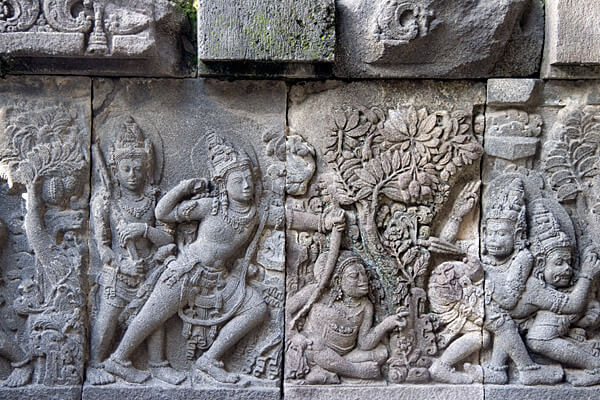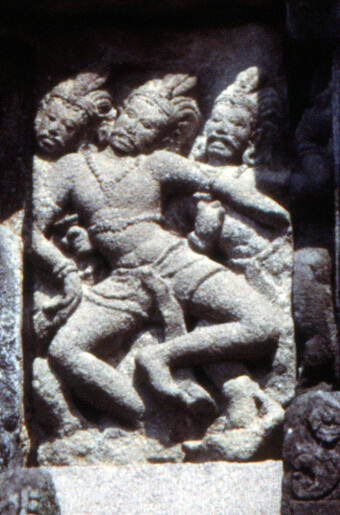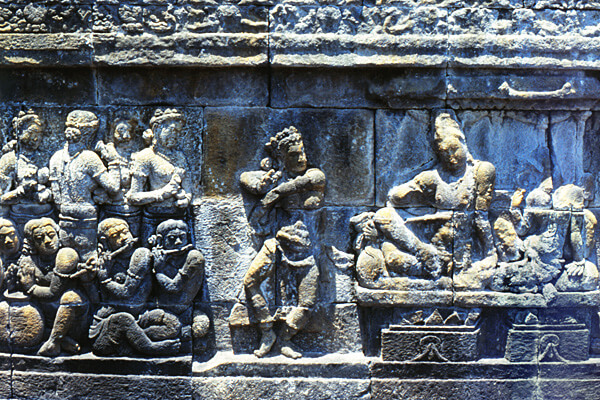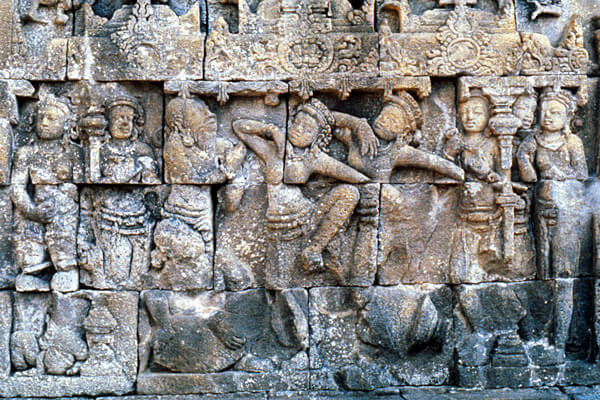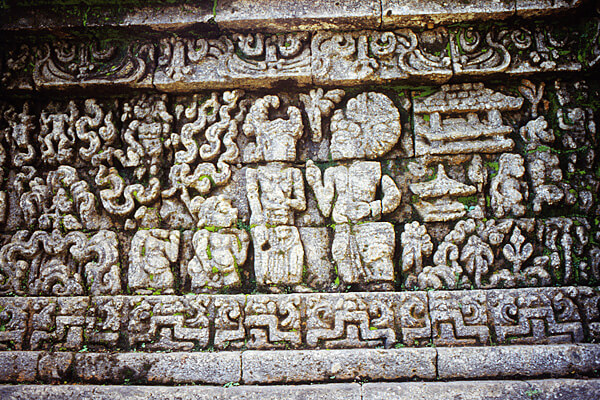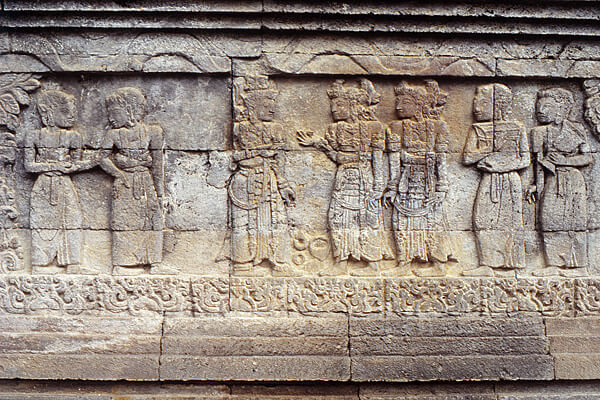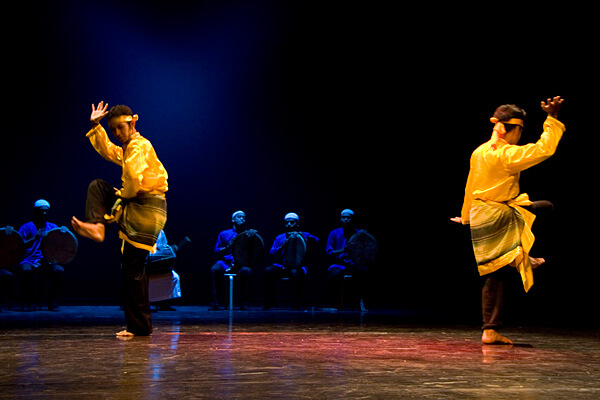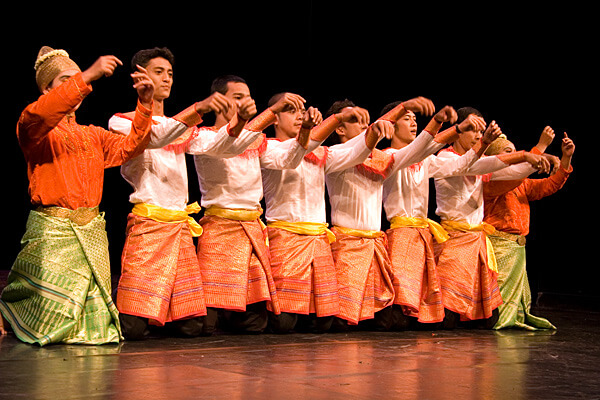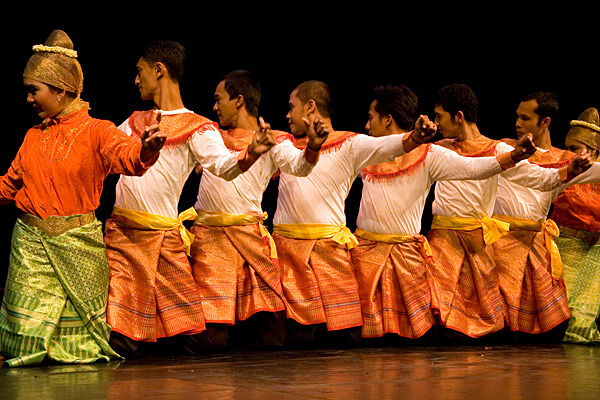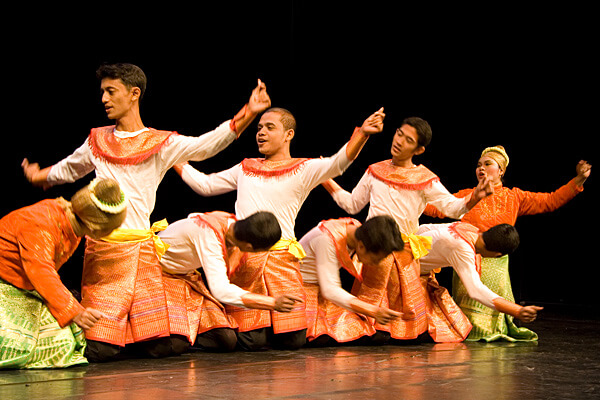Java, Indonesia’s Central Island
The long history of Java, the central island of Indonesia, is marked by international maritime contacts. The island is a natural crossroads of the sea routes between East and South Asia, and it has been the melting pot of cultural influences for thousands of years. This is clearly evident in the island’s rich traditions of theatre and dance.
The present classical forms of drama and dance were created by the Islamic courts of Central Java over the centuries. They combined old indigenous traditions with mythical story material and classical dance technique from India. Yogyakarta and Surakarta in Central Java and the capital, Jakarta, in the western part of the island are the main centres of Javanese dance and theatre today.
Several early Indianised kingdoms typical of South-East Asia flourished on the islands of Indonesia. The first of these was the Srivijaya maritime empire on the east coast of Sumatra, which controlled trade in the Malacca Straits from the 7th to the 13th centuries.
Srivijayan dominance was also felt on the island of Java, where in the 8tth and 9th centuries the Mahayana Buddhist Shailendra dynasty and its contemporary, the Hindu Sanjaya dynasty, ruled. Since both competing dynasties flourished in the central parts of the island, this epoch, generally regarded as the “classical age” of Indonesian art and architecture, is known as the Central Javanese Period.
Dance Reliefs of the Central Javanese Period, Direct Indian Influence
At the beginning of the Central Javanese period, in the early 8th century AD, the region was ruled by the Buddhist Shailendra dynasty and the Hindu Sanjaya dynasty. Thus the area was divided into two cultural spheres. The Southern part was under Buddhist influence, while the Northern part was under Hindu control. From c. 830 onward the Hindu expansion was predominant, although there seems to have existed remarkable tolerance toward Buddhism. The Central Javanese period ended for reasons not exactly known, and the transfer of political power from Central Java to East Java took place from the 10th to the early 13th centuries.
Central Javanese architecture shows a clear Indian influence. It is believed that Javanese temples or candies (ancient temples) were designed by learned Brahman priests and Buddhist monks, who acted as the scholars and scientists of their age and who either possessed the Indian architectural manuals or at least were familiar with them.
The largest of all Central Javanese Hindu temples, and indeed of all Javanese Hindu temples, is the Loro Jonggaran group, also known as Prambanan. It was constructed in c. 835–856 and it comprises altogether 227 temple towers. The three main towers are dedicated to the Hindu trimurti of Shiva, Brahma and Vishnu.
- Ramayana relief panel showing Prince Rama shooting an arrow, Prambanan Temple, Central Java, 9th century Jukka O. Miettinen
The central tower, dedicated to Shiva, rises to a height of 47 metres. The towers are decorated with narrative series of reliefs, which, in the temples dedicated to Shiva and Brahma, tell the story of the Ramayana. The exceptionally early Ramayana panels show few actual dance poses. However, they include many fixed positions related to martial arts and archery. These poses and positions found their way into the later Javanese dance techniques.
- A relief in Prambanan Temple possibly showing a karana or a dance unit described in the ancient Indian dance and theatre manual, the Natyashastra, 9th century Jukka O. Miettinen
Dance is more prominent on the outer walls of the central tower of the complex. There are 62 reliefs showing clearly Indian-influenced dance poses. It possible that these reliefs reflect the Indian system of karanas, the fixed dance units described in the Natyashastra, the Indian manual of dance and theatre, compiled in c. 100–200 AD.
The largest Buddhist building is Borobodur, which, in fact, forms a huge three-dimensional mandala with a plan of 113 by 113 metres. Started in c. 775 its construction was intended to be a Hindu temple but later the plans were, however, changed and the Buddhist Borobudur got its final form in c. 835.
The eight terraces of Bororobudur, with the crowning main stupa at the top surrounded by minor stupas, form an artificial stone mountain. The symbolism of Mount Meru, as well as other Buddhist cosmological features, is apparent.
The lower terraces are built on a square plan symbolising the earth, whereas the upper terraces with stupas are circular and represent the heavens. The lower terraces were meant for circumambulation and were decorated with some 1300 relief panels of altogether 2.5 kilometres in length. As a whole, the structure forms a huge cosmological symbol and circumambulation through the terraces were intended to show the devotee, with the aid of the reliefs, the path to enlightenment.
- Relief in the Borobudur stupa showing a dancer performing at court, 9th century Jukka O. Miettinen
The great number of reliefs on the walls of Borobudur include numerous dance images. Many of them depict dance performed at court by female dancers. Usually these court performances show a clear Indian influence. Some of the reliefs hint at how the Indian dance technique was transmitted to Java.
- Bearded Brahman instructing dancers, Borobudur, Central Java, 9th century Jukka O. Miettinen
In several reliefs we find female dancers accompanied by one or two male figures, which bear the iconographical marks of Indian Brahman priests or dance masters. These portrayals of dance performances can give one answer as to how the dance tradition was passed on to local dancers. It was simply taught to locals by the Indian Brahmans, who had the knowledge of the Indian tradition and acted as gurus, or teacher-masters as well as spiritual guides.
Although fairly many of the Central Javanese dance images show an undeniable Indian influence, it does not mean that all of them are related to the Indian tradition. Among the dance-related images one can identify several types of dances or even dance traditions, such as dance rituals, communal dances, recreational dances, martial arts dances, acrobatics, and the above-mentioned court dances.
As a general rule, the dances performed in a court context show a clear Indian influence. However, many of the dances do not seem to bear any resemblance to the Indian tradition and they may represent local, indigenous dance traditions.
The Wayang Style of the East Javanese Period, The Localisation of the Indian Influence
From the early 10th century onward the Central Javanese kings focused their attention on East Java and in 929 they seem to have almost abandoned Central Java. There has been much speculation about the reason for this drastic change. A volcanic eruption could have been the reason, which was interpreted as a warning sign from the gods. The East Javanese period can be divided into four sub-periods.
During the Majapahit period, in the 13th–15th centuries, the East Javanese culture reached its zenith. The second half of the 14th century in particular saw the flourishing of both literature and architecture. The religion of the East Javanese period was syncretistic in character, while the cults of Shiva and the Buddha merged together.
- Wayang style relief, Candi Jago, East Java, 13th–14th centuries Jukka O. Miettinen
The free-standing cult images of the period do, in fact, follow the Central Javanese, Indian-influenced tradition. A more drastic change occurred, however, in the style of the narrative reliefs, which were carved on the bases and the balustrades of the outer walls of the temples. From the beginning of the 13th century they no longer echoed the Indian-influenced, round and sensual and even realistic “classical” style but were carved in a completely new style, known as the “wayang style”.
Wayang is a generic term, which has several meanings. It means a “puppet”; it can refer to a shadow and it also refers to a performance. Generally, the shadow play, wayang kulit, is seen as the origin of the whole “wayang family”. It includes several theatrical genres from the storyteller’s scroll performances, wayang beber, to the three-dimensional wooden rod puppet theatre, wayang golek, and finally to the court dance drama wayang wong, in which living actors take the place of the wayang puppets.
All these theatre forms have much in common. Their principles of dramatic action, stylisation of movement, characterisation, costuming, basic role types etc. clearly stem from the same tradition and conventions. The earliest record confirming the existence of shadow theatre in Java dates back to 907.
The present-day Balinese puppets represent an archaic style, and bear a clear resemblance to the East Javanese wayang style reliefs. The Javanese puppets are, in turn, believed to have evolved into their extremely elongated and almost non-figurative style during the period of Muslim rule, which put an end to the East Javanese period by the end of the 15th century. It is generally believed that the extreme stylisation of Javanese puppets reflects Islam’s ban on making a human figure.
- Balinese wayang kulit puppets are still stylistically related to the wayang reliefs of East Java Jukka O. Miettinen
Like the shadow puppets, especially those from Bali, the figures in the narrative panels of the East Javanese temples also follow the conventions of the wayang tradition. The torso is shown frontally, whereas the head, legs and feet are depicted in profile. The thin arms and small hands hang down stiffly alongside the torso if they are not lifted and shown in any of the wayang theatre’s limited mudra-like gestures.
- Wayang style reliefs of Candi Panataran, East Java, 15th century Jukka O. Miettinen
The whole treatment of the reliefs is flat, while the large, decorative headdresses of the figures, the Chinese-style cloud motifs and the stylised elements of the landscape often fill the backgrounds. Besides the stylisation of the human figures, the dwarfish servant clowns, the punakawan, and the use of the tree-of-life motif as a dividing agent between the scenes also seem to connect the reliefs with the wayang kulit shadow theatre.
The stories depicted in the East Javanese series of narrative reliefs are based on the localised versions of the Ramayana and other Indian mythological themes found in the Old Javanese texts. The stories that originated in India were, by this time, merged to a great extent with local stories and embedded in the local cultural climate. One can recognise a localisation process of the same kind both in the style of the reliefs as well as in the literary themes they depict.
The mythological stories were retold and elaborated by local storytellers and court poets, while the sculptural portrayals of these stories were also localised. Thus the reliefs lost the style and iconography derived from India during the Central Javanese period, and a new completely indigenous wayang style emerged, indicating a cross-fertilisation of local theatrical conventions and the visual arts.
The Arrival of Islam
Majapahit power gradually declined in the fifteenth century with the spread of Islam, and Malacca, the first of the South-East Asian sultanates, rose to power in the Malay Peninsula. Islam spread gradually from North Sumatra to Java, where Demak, the first Islamic centre, began to break away from Majapahit rule. In 1527, together with its neighbouring towns, it succeeded in crushing the Majapahit dynasty, bringing to an end the Hindu-Buddhist East Javanese period.
According to legend, Islam was introduced into Java by nine holy men (wali). The most famous of these was Sunan Kali Jogo, who is believed to have spread the teachings of Islam by means of shadow-theatre performances of the Hindu Mahabharata. This legend clearly demonstrates the specific features of Islam in Java. Instead of wiping out earlier beliefs, it assimilated them.
This led to a syncretistic belief system typical of Java, which combines animism, Buddhism, Hinduism, and Islam and has had a clear effect on the arts, including theatre and dance. As before, the ruler was regarded as divine, and the cult of the god-king and court culture retained many Hindu-Buddhist features of earlier times.
Islamic Traditions of Performing Arts
Islam has not produced many forms of dance and theatre. The tradition of Islam (not Quran itself) takes a negative attitude towards portraying a human form in the visual arts. The only art form referred to in the Islamic tradition is the recitation of the holy Quran.
When Islam started to spread across the islands of Indonesia in the 12th century, it was also bringing new kinds of cultural influences from the Islamic world, from Arab culture, Persia and Islamic West India. They included literature, types of instruments, forms of music, styles of recitation of holy texts, and also some forms of dance.
In many cases these new elements were quickly localised and they intermingled with earlier animistic and Hindu-Buddhist elements. A good example is wayang golek rod puppet theatre, which has its roots firmly in the older wayang kulit shadow theatre that mainly deals with Hindu mythology. Wayang golek, however, takes its main plot material from the Islamic Menak stories. A similar kind of fusion of cultural layers can be recognised in numerous Indonesian traditions.
- A dance from Aceh, based on the movements of silek martial arts Jukka O. Miettinen
More purely Islamic traditions can be found on the island of Sumatra, particularly on its northernmost tip, Aceh, from where Islam started to spread to other parts of Indonesia. These traditions include, for example, certain musical styles, as well as dances, which are based on the local martial arts technique, silek.
Video clip: Group dancing and singing from Aceh Veli Rosenberg
Forms of group dancing and singing (seudati and remplis mude) in which the formerly all-male cast use their own bodies to create music by singing, snapping their fingers and slapping their chests and legs are also popular. The lines sung are often religious texts, and it is believed that the tradition was inspired by the ecstatic rituals of the Muslim sufi mystics.
The Islamic Renaissance of Central Java and the Colonial Period
After a period of dynastic warfare, the Mataram dynasty came to power, and Central Java again rose in political influence. One of the most important sultans of this dynasty was Agung (1613–1645), whose court in Yogyakarta ruled over the whole of East Java and other regions. Still existing dance forms as well as many mask and martial dances are known to have been performed at the court of Mataram.
- A sung dance in a row formation from Aceh. The dancers themselves provide music by slapping their chests and legs Jukka O. Miettinen
- A sung dance in a row formation from Aceh. The dancers themselves provide music by slapping their chests and legs Jukka O. Miettinen
In the sixteenth century the island of Java had begun to interest Westerners who were seeking spices. In 1602 the Dutch established their trading company, the Vereenigde Oost-indische Compagnie, which led to a long period of Dutch hegemony on the islands of Indonesia. In 1619 the town of Batavia was founded at the site of the former village of Jayakarta. This miniature Amsterdam became a major port of trade and the centre of Dutch rule.
The British were the main competitors in these areas, and they succeeded in acquiring dominance over Java from 1811 to 1816. After Dutch rule had been re-established, the actual colonial period began in 1830, when the Dutch gained control of the whole of Java.
The Mataram dynasty expended its energies in the Javanese Wars of Succession. In 1755 the dynasty split into two, and two capitals, Yogyakarta (Yogya) and Surakarta (Solo), were founded only a few dozen kilometres from each other near the ancient Central Javanese temples. In both cities the most important part is the kraton (also known as keraton), the sultan’s palace enclosed by walls and forming a city within a city.
The symbolic features of the plan of the kraton clearly reflect ancient Hindu and Buddhist cosmology. The outermost parts of the kraton were reserved for the army and the court officials and their families. The interior consisted of several open administrative buildings serving various ceremonial functions. The sultan resided in the most protected central part, and, in accordance with old Hindu-Buddhist custom, he was regarded as divine.
In the early nineteenth century the royal families of Yogyakarta and Surakarta again divided, leading to a politically precarious situation where the two capitals were simultaneously ruled by two sultans in each. When full political power was taken over by the Dutch, the ruling families of Java concentrated their energies on refining court etiquette and on developing the arts, especially theatre, dance, and music. This led to a unique renaissance of the arts, in which the classical genres of Central Javanese theatre and dance found their present forms.
Early Independence
The rise of nationalism among Javanese intellectuals in the early twentieth century anticipated a period of political turmoil, which was later inflamed by World War II. The Japanese ousted the Dutch and occupied Java from 1942 to 1945. On 17 August 1945, after the end of the Japanese Occupation, Indonesia declared its independence. Yogyakarta was for a short time the temporary capital, and the seat of government was later moved to the Dutch-built city of Batavia, now renamed Jakarta. The Republic of Indonesia was established in 1950 with Dr A. Sukarno as its first elected president.
For over a thousand years, wayang kulit shadow theatre has been the core of Javanese theatre, influencing the development of other genres. Over the centuries, the various sultanates with their kraton have developed their own art forms by adapting and combining ancient Hindu-Buddhist traditions in the spirit of Islam.
Java is also home to various classical forms of gamelan music and dance styles, of which the most important ones are the West Javanese style (Sunda), the East Javanese style, and the Central Javanese style, whose best-known traditions were refined in the kratons of Yogyakarta and Surakarta. The Central Javanese dance style can be described as the most classical dance style of Java. During the period of Indonesian independence the dance style of Java and its theatre traditions have spread to other islands, forming a kind of pan-Indonesian style.
